LoRa, Zigbee and 5G Propagation and Transmission Performance in an Indoor Environment at 868 MHz
Abstract
1. Introduction
1.1. Technologies
1.2. Related Works
1.3. Motivation
2. Measurement Setup Description
2.1. Measurement Scenario
2.2. Measurement Equipment
3. Methodology
3.1. Ideal Narrowband Measurements at 868 MHz
3.2. LoRa Measurement Descriptions
3.2.1. Pycom Transmitter Module
- Generate a known data string.
- Send this chain to another Pycom module wirelessly and at a certain speed.
3.2.2. Receiver Pycom Module
- Receive the characters sent by the other module.
- Carry out an analysis of the data obtained in order to be able to estimate both the signal quality rate (BER) and the signal power (RSSI) at each point.
3.3. Zigbee Measurement Descriptions
3.3.1. XBee Transmitter Module
3.3.2. Receiver XBee Module
3.4. 5G QPSK at 868 MHz Measurement Descriptions
3.5. Distance Metric
3.6. Power Metric
3.7. Quality Metric
3.8. Measured Path Loss
4. Radio Channel Models
5. Measurement Results and Discussion
5.1. Power Measurements and Path Loss Modeling
5.1.1. Narrowband at 868 MHz
5.1.2. LoRa at 868 MHz
5.1.3. Zigbee at 868 MHz
5.1.4. 5G QPSK at 868 MHz
5.1.5. Discussion of Path Loss Models
- The results of the CI and FI models in the NLOS-1 zone exhibit behavior very similar to the results of other studies under LOS conditions.
- The CI model provides a correct fit for LOS measurements but is not suitable for NLOS measurements. This model considers the physical behavior of the propagation using the n parameter since it adjusts the path loss to a reference distance . Because it is fitted by a reference parameter, it is possible to compare the results of different measurement campaigns immediately.
- The FI model provides the best fit for both LOS and NLOS situations because the fit is made by two free parameters, and , although it is difficult to compare results and draw immediate conclusions.
- The CI and FI models give the same result when and are equal [38]. This can only occur in the LOS situation, as this is when both models could have the same behavior.
- The CI and FI models are practically very similar in LOS measurements; in NLOS measurements, they vary significantly from each other.
- For narrowband transmission, the slope in the NLOS-1 zone is very close to the free space propagation value with a small waveguide effect. For the NLOS-2 zone, the slope value increases considerably due to a large energy loss in diffraction at the R1 point.
- For narrowband transmission and LoRa RSSI, in general, the power measurements performed have a very similar behavior between one technology and the other, with the nuance that LoRa has somewhat lower losses in the NLOS-2 zone. As shown in Figure 13, the received power curve of the narrowband transmission is very similar to that of the LoRa RSSI, previously raised by means of an offset. This offset is calculated as the difference in the mean of the narrowband transmission power measurements with the mean of the LoRa RSSI measurements. The error is calculated as the absolute value of the difference in each point of the narrowband transmission power measurement with the LoRa RSSI measurement after shifting the LoRa RSSI point cloud by adding the offset.
- For the RSSI of LoRa and Zigbee, continuing with the previous point, we can observe how the behavior of the RSSI measurements of both LoRa and Zigbee is very similar to the power measurements of narrowband transmission, with the slight differences indicated above, so we can conclude that the RSSI measurements are reliable to make a propagation loss model.
- For LoRa RSSI, the slope in the NLOS-1 zone is less close to the free space propagation, so some waveguide effect is present. In the NLOS-2 zone, the slope increases due to diffraction losses at the R1 point, but it is observed that the value is considerably lower than in narrowband transmission due to the robustness of LoRa CSS modulation.
- For Zigbee RSSI, the NLOS-1 slope is almost identical to the LoRa transmission because they experience the same waveguide effects. In the NLOS-2 zone, it was not possible to measure because the signal attenuated before reaching the R1 point due to the low power at which Zigbee transmits and its lower receive sensitivity.
- For 5G SS-RSRP, it is the transmission that attenuates less with distance and suffers a very noticeable waveguide effect, seeing that its slope value is very close to 1 in the NLOS-1 zone for the FI model. On the other hand, in the NLOS-2 zone, it has a higher slope than LoRa transmission and a very similar to narrowband transmission. Therefore, it is observed that 5G transmission shows the least slope in the NLOS-1 zone, while in the NLOS-2 zone, it shows a higher slope.
5.2. BER Measurements and Relation with the FI Path Loss Model
5.2.1. LoRa BER
5.2.2. Zigbee BER
5.2.3. 5G QPSK SS-RSRQ
6. Conclusions
Author Contributions
Funding
Institutional Review Board Statement
Informed Consent Statement
Data Availability Statement
Acknowledgments
Conflicts of Interest
Abbreviations
| 4G | Fourth-generation technology standard for broadband cellular networks |
| 5G | Fifth-generation technology standard for broadband cellular networks |
| BER | Bit error rate |
| CDF | Cumulative distribution function |
| CI | Close-in |
| CSS | Chirp spread spectrum |
| CW | Continuous wave |
| DS-CDMA | Direct sequence Code Division Multiple Access |
| FDMA | Frequency Division Multiple Access |
| FI | Floating-Intercept |
| GHz | Giga Hertz |
| IoT | Internet of Things |
| ISM | Industrial, Scientific and Medical |
| JSON | JavaScript Object Notation |
| LOS | Line-of-sight |
| LPWAN | Low-Power Wide Area Networks |
| LTE | Long-Term Evolution |
| M2M | Machine-to-machine |
| MHz | Mega Hertz |
| mmWave | Millimeter-wave |
| NB | Narrowband |
| NLOS | Non-line-of-sight |
| NR | New Radio |
| OFDM | Orthogonal frequency division multiplexing |
| QPSK | Quadrature Phase-Shift Keying |
| RF | Radio frequency |
| RSSI | Received Signal Strength Indicator |
| Rx | Receiver |
| SA | Spectrum analyzer |
| SCPI | Standard Commands for Programmable Instruments |
| SS-RINR | Secondary Synchronization signal-Signal to Interference-plus-Noise Ratio |
| SS-RSRP | Synchronization Signal-Reference Signal Received Power |
| SS-RSRQ | Synchronization Signal-Reference Signal Received Quality |
| SSB | Synchronization Signal Block |
| Tx | Transmitter |
| UHF | Ultra High Frequency |
| V2V | Vehicle-to-vehicle |
| V2X | Vehicle-to-X |
| WPAN | Wireless personal area networks |
| WSN | Wireless sensor networks |
References
- Lin, C.C.; Deng, D.J.; Chen, Z.Y.; Chen, K.C. Key design of driving industry 4.0: Joint energy-efficient deployment and scheduling in group-based industrial wireless sensor networks. IEEE Commun. Mag. 2016, 54, 46–52. [Google Scholar] [CrossRef]
- Ehrlich, M.; Wisniewski, L.; Jasperneite, J. State of the Art and Future Applications of Industrial Wireless Sensor Networks. In Kommunikation und Bildverarbeitung in der Automation; Springer: Berlin/Heidelberg, Germany, 2018; pp. 28–39. [Google Scholar]
- Low, K.S.; Win, W.; Er, M.J. Wireless Sensor Networks for Industrial Environments. In Proceedings of the International Conference on Computational Intelligence for Modelling, Control and Automation and International Conference on Intelligent Agents, Web Technologies and Internet Commerce (CIMCA-IAWTIC’06), Vienna, Austria, 28–30 November 2005; pp. 271–276. [Google Scholar]
- Cheffena, M. Propagation Channel Characteristics of Industrial Wireless Sensor Networks [Wireless Corner]. IEEE Antennas Propag. Mag. 2016, 58, 66–73. [Google Scholar] [CrossRef]
- Lavric, A.; Petrariu, A. LoRaWAN communication protocol: The new era of IoT. In Proceedings of the International Conference on Development and Application Systems (DAS), Suceava, Romania, 24–26 May 2018; pp. 74–77. [Google Scholar]
- Ramya, C.; Shanmugaraj, M.; Prabakaran, R. Study on ZigBee technology. In Proceedings of the 3rd International Conference on Electronics Computer Technology, Kanyakumari, India, 8–10 April 2011; pp. 297–301. [Google Scholar]
- Agiwal, M.; Roy, A.; Saxena, N. Next Generation 5G Wireless Networks: A Comprehensive Survey. IEEE Commun. Surv. Tutor. 2016, 18, 1617–1655. [Google Scholar] [CrossRef]
- Raza, U.; Kulkarni, P.; Sooriyabandara, M. Low Power Wide Area Networks: An Overview. IEEE Commun. Surv. Tutor. 2017, 19, 855–873. [Google Scholar] [CrossRef]
- Centenaro, M.; Vangelista, L.; Zanella, A.; Zorzi, M. Long-range communications in unlicensed bands: The rising stars in the IoT and smart city scenarios. IEEE Wirel. Commun. 2016, 23, 60–67. [Google Scholar] [CrossRef]
- Madeo, D.; Pozzebon, A.; Mocenni, C.; Bertoni, D. A Low-Cost Unmanned Surface Vehicle for Pervasive Water Quality Monitoring. IEEE Trans. Instrum. Meas. 2020, 69, 1433–1444. [Google Scholar] [CrossRef]
- Manzano, L.; Boukabache, H.; Danzeca, S.; Heracleous, N.; Murtas, F.; Perrin, D.; Pirc, V.; Alfaro, A.; Zimmaro, A.; Silari, M. An IoT LoRaWAN Network for Environmental Radiation Monitoring. IEEE Trans. Instrum. Meas. 2021, 70, 1–12. [Google Scholar] [CrossRef]
- Rizzi, M.; Ferrari, P.; Flammini, A.; Sisinni, E. Evaluation of the IoT LoRaWAN Solution for Distributed Measurement Applications. IEEE Trans. Instrum. Meas. 2017, 66, 3340–3349. [Google Scholar] [CrossRef]
- Chacon-Troya, D.; García, A. Indoor propagation analysis applied in ZigBee networks. In Proceedings of the IEEE First International Smart Cities Conference (ISC2), Guadalajara, Mexico, 25–28 October 2015; pp. 1–5. [Google Scholar]
- Yadav, D.; Mishra, P.; Jayanthu, S.; Das, S. Fog-IoT-Based Slope Monitoring (FIoTSM) System With LoRa Communication in Open-Cast Mine. IEEE Trans. Instrum. Meas. 2021, 70, 1–11. [Google Scholar] [CrossRef]
- Rao, T.; Balachander, D.; Chamberlin, K. Path gain measurements at 868/915 MHz for Wireless Sensor Communications in indoor corridors. In Proceedings of the Fifth IEEE International Conference on Advanced Telecommunication Systems and Networks (ANTS), Bangalore, India, 18–21 December 2011; pp. 1–3. [Google Scholar]
- Rama Rao, T.; Balachander, D.; Tiwari, N. Short-range near floor path gain measurements in indoor corridors at UHF for wireless sensor communications. In Proceedings of the IEEE International Conference on Communication Systems (ICCS), Singapore, 21–23 November 2012; pp. 189–193. [Google Scholar]
- Molina-Garcia-Pardo, J.M.; Rodriguez, J.V.; Juan-Llacer, L. Polarized Indoor MIMO Channel Measurements at 2.45 GHz. IEEE Trans. Antennas Propag. 2008, 56, 3818–3828. [Google Scholar] [CrossRef]
- Garcia-Pardo, C.; Molina-Garcia-Pardo, J.M.; Garrido-Cervantes, A.; Muhehe, J.; Juan-Llacer, L. Frequency Dependence of 2–5 GHz Polarized UWB Channel Parameters in Office Environment. IEEE Trans. Antennas Propag. 2012, 60, 2970–2979. [Google Scholar] [CrossRef]
- Ojo, M.; Adami, D.; Pagano, M.; Giordano, S.; Niccolini, M. Design, Implementation and Evaluation of a LoRa Packet Generator for Forest Environments. In Proceedings of the IEEE 26th International Workshop on Computer Aided Modeling and Design of Communication Links and Networks (CAMAD), Porto, Portugal, 25–27 October 2021; pp. 1–6. [Google Scholar]
- Trinh, L.; Bui, V.; Ferrero, F.; Nguyen, T.; Le, M. Signal propagation of LoRa technology using for smart building applications. In Proceedings of the IEEE Conference on Antenna Measurements & Applications (CAMA), Tsukuba, Japan, 4–6 December 2017; pp. 381–384. [Google Scholar]
- Van Torre, P.; Ameloot, T.; Rogier, H. Long-range body-to-body LoRa link at 868 MHz. In Proceedings of the 13th European Conference on Antennas and Propagation (EuCAP), Krakow, Poland, 31 March–5 April 2019; pp. 1–5. [Google Scholar]
- Dieng, O.; Pham, C.; Thiare, O. Comparing and Adapting Propagation Models for LoRa Networks. In Proceedings of the 16th International Conference on Wireless and Mobile Computing, Networking and Communications (WiMob), Thessaloniki, Greece, 12–14 October 2020; pp. 1–7. [Google Scholar]
- Bianco, G.; Mejia-Aguilar, A.; Marrocco, G. Radio wave propagation of LoRa systems in mountains for Search and Rescue operations. In Proceedings of the XXXIIIrd General Assembly and Scientific Symposium of the International Union of Radio Science, Rome, Italy, 29 August–5 September 2020; pp. 1–3. [Google Scholar]
- Branch, P. Propagation Measurements and Models of 915 MHz LoRa Radio in a Block Cave Gold Mine. In Proceedings of the International Conference on Information Networking (ICOIN), Jeju Island, Republic of Korea, 13–16 January 2021; pp. 333–338. [Google Scholar]
- Bertoldo, S.; Paredes, M.; Carosso, L.; Allegretti, M.; Savi, P. Empirical indoor propagation models for LoRa radio link in an office environment. In Proceedings of the 13th European Conference on Antennas and Propagation (EuCAP), Krakow, Poland, 31 March–5 April 2019; pp. 1–5. [Google Scholar]
- Hosseinzadeh, S.; Larijani, H.; Curtis, K.; Wixted, A.; Amini, A. Empirical propagation performance evaluation of LoRa for indoor environment. In Proceedings of the IEEE 15th International Conference on Industrial Informatics (INDIN), Emden, Germany, 24–26 July 2017; pp. 26–31. [Google Scholar]
- Gregora, L.; Vojtech, L.; Neruda, M. Indoor signal propagation of LoRa technology. In Proceedings of the 17th International Conference on Mechatronics—Mechatronika (ME), Prague, Czech Republic, 7–9 December 2016; pp. 1–4. [Google Scholar]
- Inagaki, K.; Narieda, S.; Fujii, T.; Umebayashi, K.; Naruse, H. Measurements of LoRa Propagation in Harsh Environment: Numerous NLOS Areas and Ill-Conditioned LoRa Gateway. In Proceedings of the IEEE 90th Vehicular Technology Conference (VTC2019-Fall), Honolulu, HI, USA, 22–25 September 2019; pp. 1–5. [Google Scholar]
- Masadan, N.; Habaebi, M.; Yusoff, S. LoRa LPWAN Propagation Channel Modelling in IIUM Campus. In Proceedings of the 7th International Conference on Computer and Communication Engineering (ICCCE), Kuala Lumpur, Malaysia, 19–20 September 2018; pp. 14–19. [Google Scholar]
- Zhang, X.; Shrestha, R.; Wahid, K. An efficient algorithm for localization using RSSI based on ZigBee. In Proceedings of the IEEE 28th Canadian Conference on Electrical and Computer Engineering (CCECE), Halifax, NS, Canada, 3–6 May 2015; pp. 266–369. [Google Scholar]
- Gao, L.; Lan, Y.D. Transmission Distance Estimation and Testing for 2.4GHz ZigBee Applications. In Proceedings of the Fourth International Conference on Emerging Intelligent Data and Web Technologies, Xi’an, China, 9–11 September 2013; pp. 27–32. [Google Scholar]
- Pellegrini, M.R.; Persia, S.; Volponi, D.; Marcone, G. ZigBee Sensor Network propagation analysis for health-care application. In Proceedings of the Fifth International Conference on Broadband and Biomedical Communications, Malaga, Spain, 15–17 December 2010; pp. 1–6. [Google Scholar]
- Adi, P.; Mukti, F.; Adi, P.; Kitagawa, A.; Yanris, G.J.; Sihombing, V.; Siregar, Z. ZigBee and LoRa performances on RF Propagation on the Snow Hills area. In Proceedings of the International Conference on Converging Technology in Electrical and Information Engineering (ICCTEIE), Bandar Lampung, Indonesia, 27–28 October 2021; pp. 36–41. [Google Scholar]
- Fink, J.; Michael, N.; Kushleyev, A.; Kumar, V. Experimental characterization of radio signal propagation in indoor environments with application to estimation and control. In Proceedings of the IEEE/RSJ International Conference on Intelligent Robots and Systems, St. Louis, MO, USA, 10–15 October 2009; pp. 2834–2839. [Google Scholar]
- Shen, Y.; Shao, Y.; Xi, L.; Zhang, H.; Zhang, J. Millimeter-Wave Propagation Measurement and Modeling in Indoor Corridor and Stairwell at 26 and 38 GHz. IEEE Access 2021, 9, 87792–87805. [Google Scholar] [CrossRef]
- Kim, M.D.; Liang, J.; Kwon, H.K.; Lee, J. Path loss measurement at indoor commercial areas using 28 GHz channel sounding system. In Proceedings of the 17th International Conference on Advanced Communication Technology (ICACT), PyeongChang, Republic of Korea, 1–3 July 2015; pp. 535–538. [Google Scholar]
- Elmezughi, M.; Afullo, T.; Oyie, N. Performance study of path loss models at 14, 18, and 22 GHz in an indoor corridor environment for wireless communications. SAIEE Afr. Res. J. 2021, 112, 32–45. [Google Scholar] [CrossRef]
- Elmezughi, M.; Afullo, T.; Oyie, N. Investigating the Impact of Antenna Heights on Path Loss Models in an Indoor Corridor Environment. In Proceedings of the International Conference on Artificial Intelligence, Big Data, Computing and Data Communication Systems (icABCD), Durban, South Africa, 6–7 August 2020; pp. 1–7. [Google Scholar]
- Al-Samman, A.; Rahman, T.; Azmi, M.; Sharaf, A.; Yamada, Y.; Alhammadi, A. Path loss model in indoor environment at 40 GHz for 5G wireless network. In Proceedings of the IEEE 14th International Colloquium on Signal Processing & Its Applications (CSPA), Penang, Malaysia, 9–10 March 2018; pp. 7–12. [Google Scholar]
- Huang, F.; Tian, L.; Zheng, Y.; Zhang, J. Propagation Characteristics of Indoor Radio Channel from 3.5 GHz to 28 GHz. In Proceedings of the EEE 84th Vehicular Technology Conference (VTC-Fall), Montreal, QC, Canada, 18–21 September 2016; pp. 1–5. [Google Scholar]
- Maccartney, G.; Rappaport, T.; Sun, S.; Deng, S. Indoor Office Wideband Millimeter-Wave Propagation Measurements and Channel Models at 28 and 73 GHz for Ultra-Dense 5G Wireless Networks. IEEE Access 2015, 3, 2388–2424. [Google Scholar] [CrossRef]
- Joo, J.; Eyobu, O.; Han, D.; Jeong, H.J. Measurement based V2V path loss analysis in urban NLOS scenarios. In Proceedings of the Eighth International Conference on Ubiquitous and Future Networks (ICUFN), Vienna, Austria, 5–8 July 2016; pp. 73–75. [Google Scholar]
- Andersen, J.; Rappaport, T.; Yoshida, S. Propagation measurements and models for wireless communications channels. IEEE Commun. Mag. 1995, 33, 42–49. [Google Scholar] [CrossRef]
- Rappaport, T.; McGillem, C. UHF fading in factories. IEEE J. Sel. Areas Commun. 1989, 7, 40–48. [Google Scholar] [CrossRef]
- Rappaport, T. Characterization of UHF multipath radio channels in factory buildings. IEEE Trans. Antennas Propag. 1989, 37, 1058–1069. [Google Scholar] [CrossRef]
- Seidel, S.; Rappaport, T. 914 MHz path loss prediction models for indoor wireless communications in multifloored buildings. IEEE Trans. Antennas Propag. 1992, 40, 207–217. [Google Scholar] [CrossRef]
- Rappaport, T.; Sandhu, S. Radio-wave propagation for emerging wireless personal-communication systems. IEEE Antennas Propag. Mag. 1994, 36, 14–24. [Google Scholar] [CrossRef]
- Ghassemzadeh, S.; Jana, R.; Rice, C.; Turin, W.; Tarokh, V. Measurement and modeling of an ultra-wide bandwidth indoor channel. IEEE Trans. Commun. 2004, 52, 1786–1796. [Google Scholar] [CrossRef]
- Devasirvatham, D. A comparison of time delay spread and signal level measurements within two dissimilar office buildings. IEEE Trans. Antennas Propag. 1987, 35, 319–324. [Google Scholar] [CrossRef]
- Alwarafy, A.; Sulyman, A.; Alsanie, A.; Alshebeili, S.; Behairy, H. Receiver spatial diversity propagation path-loss model for an indoor environment at 2.4 GHz. In Proceedings of the 6th International Conference on the Network of the Future (NOF), Montreal, QC, Canada, 30 September–2 October 2015; pp. 1–4. [Google Scholar]
- Sun, S.; Rappaport, T.; Thomas, T.; Ghosh, A.; Nguyen, H.; Kovács, I.; Rodriguez, I.; Koymen, O.; Partyka, A. Investigation of Prediction Accuracy, Sensitivity, and Parameter Stability of Large-Scale Propagation Path Loss Models for 5G Wireless Communications. IEEE Trans. Veh. Technol. 2016, 65, 2843–2860. [Google Scholar] [CrossRef]
- Majed, M.B.; Rahman, T.A.; Aziz, O.A.; Hindia, M.N.; Hanafi, E. Channel characterization and path loss modeling in indoor environment at 4.5, 28, and 38 GHz for 5G cellular networks. Int. J. Antennas Propag. 2018, 2018, 9142367. [Google Scholar] [CrossRef]
- Levie, R.; Yapar, Ç.; Kutyniok, G.; Caire, G. Pathloss Prediction using Deep Learning with Applications to Cellular Optimization and Efficient D2D Link Scheduling. In Proceedings of the ICASSP 2020—2020 IEEE International Conference on Acoustics, Speech and Signal Processing (ICASSP), Barcelona, Spain, 4–8 May 2020; pp. 8678–8682. [Google Scholar]
- Mao, K.; Zhu, Q.; Song, M.; Li, H.; Ning, B.; Pedersen, G.; Fan, W. Machine-Learning-Based 3-D Channel Modeling for U2V mmWave Communications. IEEE Internet Things J. 2022, 9, 17592–17607. [Google Scholar] [CrossRef]
- Li, H.; Chen, X.; Mao, K.; Zhu, Q.; Qiu, Y.; Ye, X.; Zhong, W.; Lin, Z. Air-to-ground path loss prediction using ray tracing and measurement data jointly driven DNN. Comput. Commun. 2022, 196, 268–276. [Google Scholar] [CrossRef]
- Gui, J.; Dai, X.; Deng, X. Stabilizing Transmission Capacity in Millimeter Wave Links by Q-Learning-Based Scheme. Mob. Inf. Syst. 2020, 2020, 7607316. [Google Scholar] [CrossRef]
- Pimienta-del-Valle, D.; Mendo, L.; Riera, J.; Garcia-del-Pino, P. Path Loss Results in an Indoor Corridor Scenario at the 26, 32 and 39 GHz Millimeter-Wave Bands. In Proceedings of the 15th European Conference on Antennas and Propagation (EuCAP), Dusseldorf, Germany, 22–26 March 2021; pp. 1–5. [Google Scholar]
- Rappaport, T. Wireless Communications: Principles and Practice, 2nd ed.; Prentice-Hall, Inc.: Upper Saddle River, NJ, USA, 2002. [Google Scholar]
- Rappaport, T.; MacCartney, G.; Samimi, M.; Sun, S. Wideband Millimeter-Wave Propagation Measurements and Channel Models for Future Wireless Communication System Design. IEEE Trans. Commun. 2015, 63, 3029–3056. [Google Scholar] [CrossRef]
- Zafari, F.; Gkelias, A.; Leung, K. A Survey of Indoor Localization Systems and Technologies. IEEE Commun. Surv. Tutor. 2019, 21, 2568–2599. [Google Scholar] [CrossRef]
- Semtech Corporation. AN1200.22 LoRa Modulation Basics; Rev. 2; Semtech Corporation: Camarillo, CA, USA, 2015. [Google Scholar]
- Lee, A.K.; Jeon, S.B.; Choi, H.D. EMF Levels in 5G New Radio Environment in Seoul, Korea. IEEE Access 2021, 9, 19716–19722. [Google Scholar] [CrossRef]
- Al-Samman, A.; Hindia, M.; Rahman, T. Path loss model in outdoor environment at 32 GHz for 5G system. In Proceedings of the 2016 IEEE 3rd International Symposium on Telecommunication Technologies (ISTT), Kuala Lumpur, Malaysia, 28–30 November 2016; pp. 9–13. [Google Scholar]
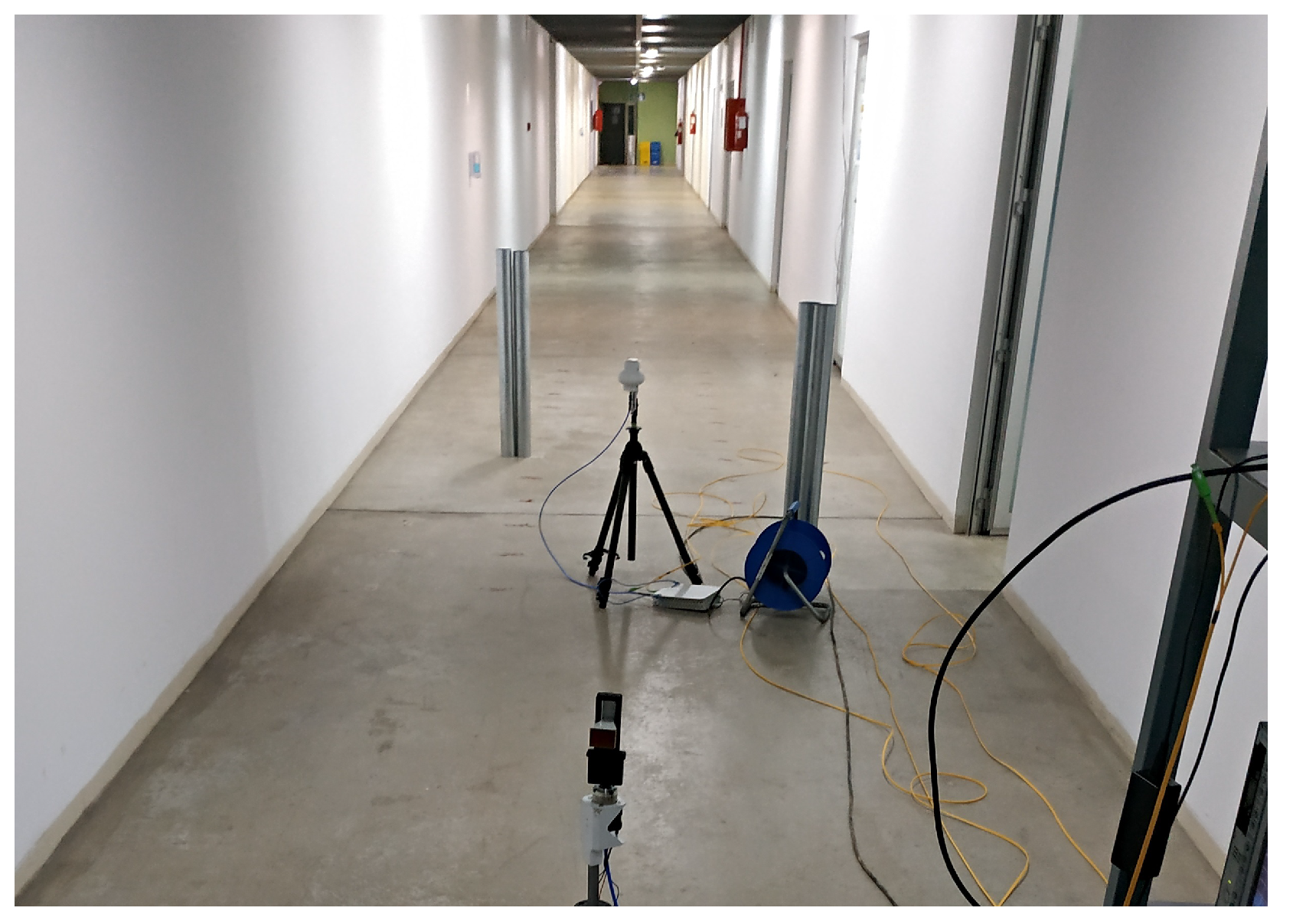


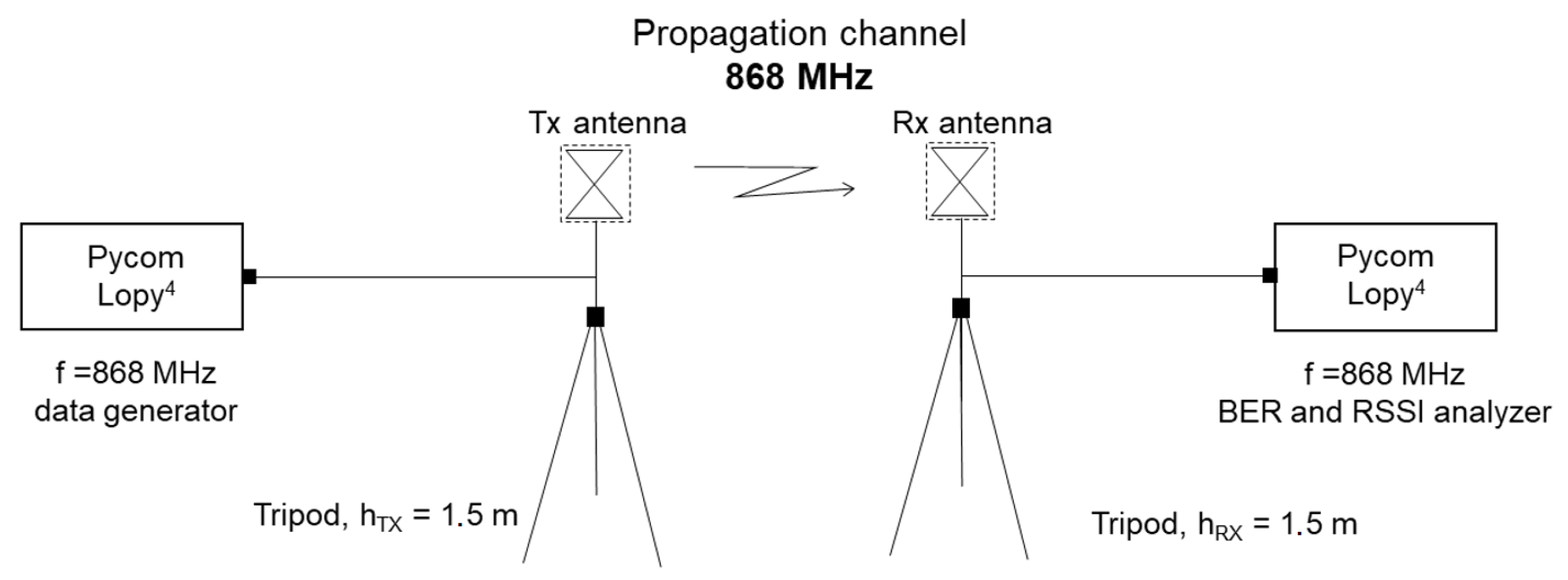

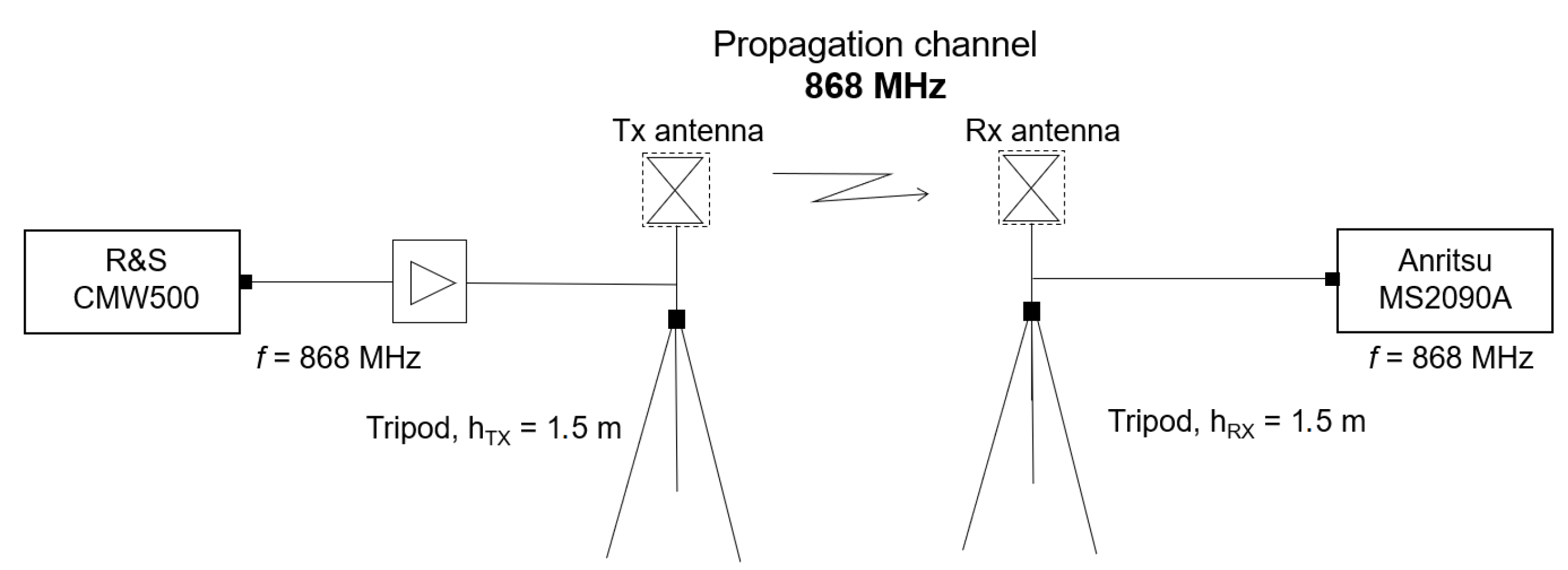
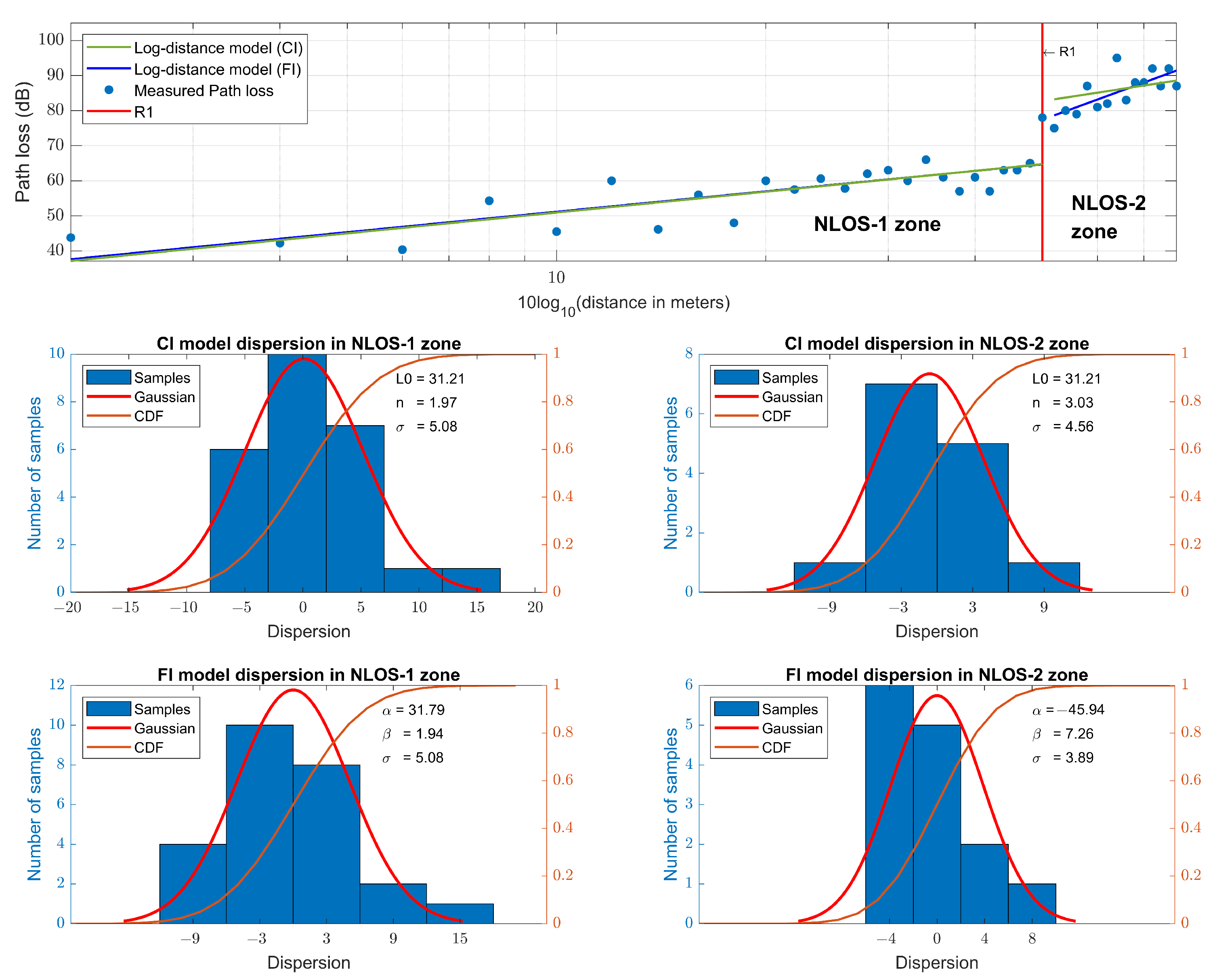
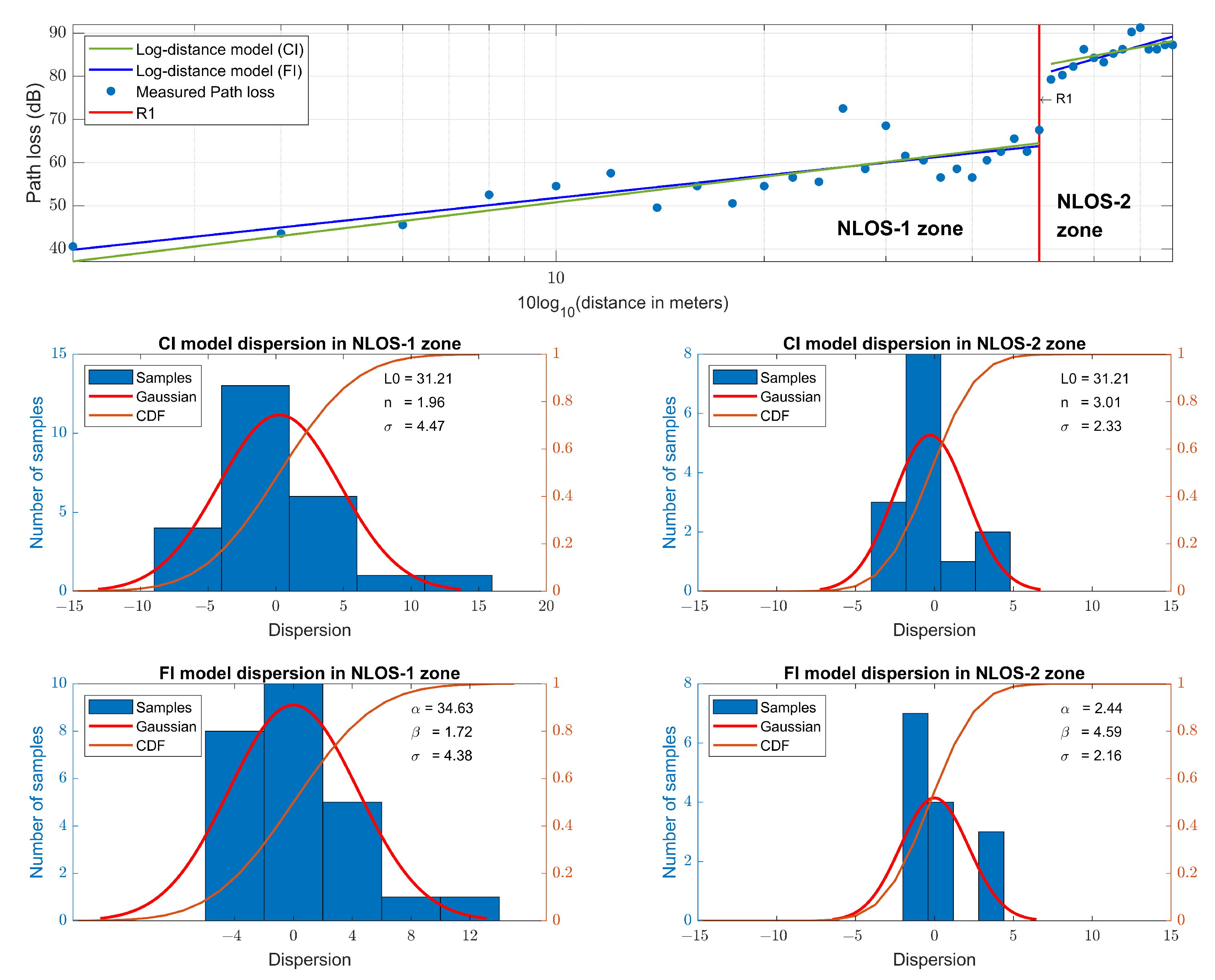

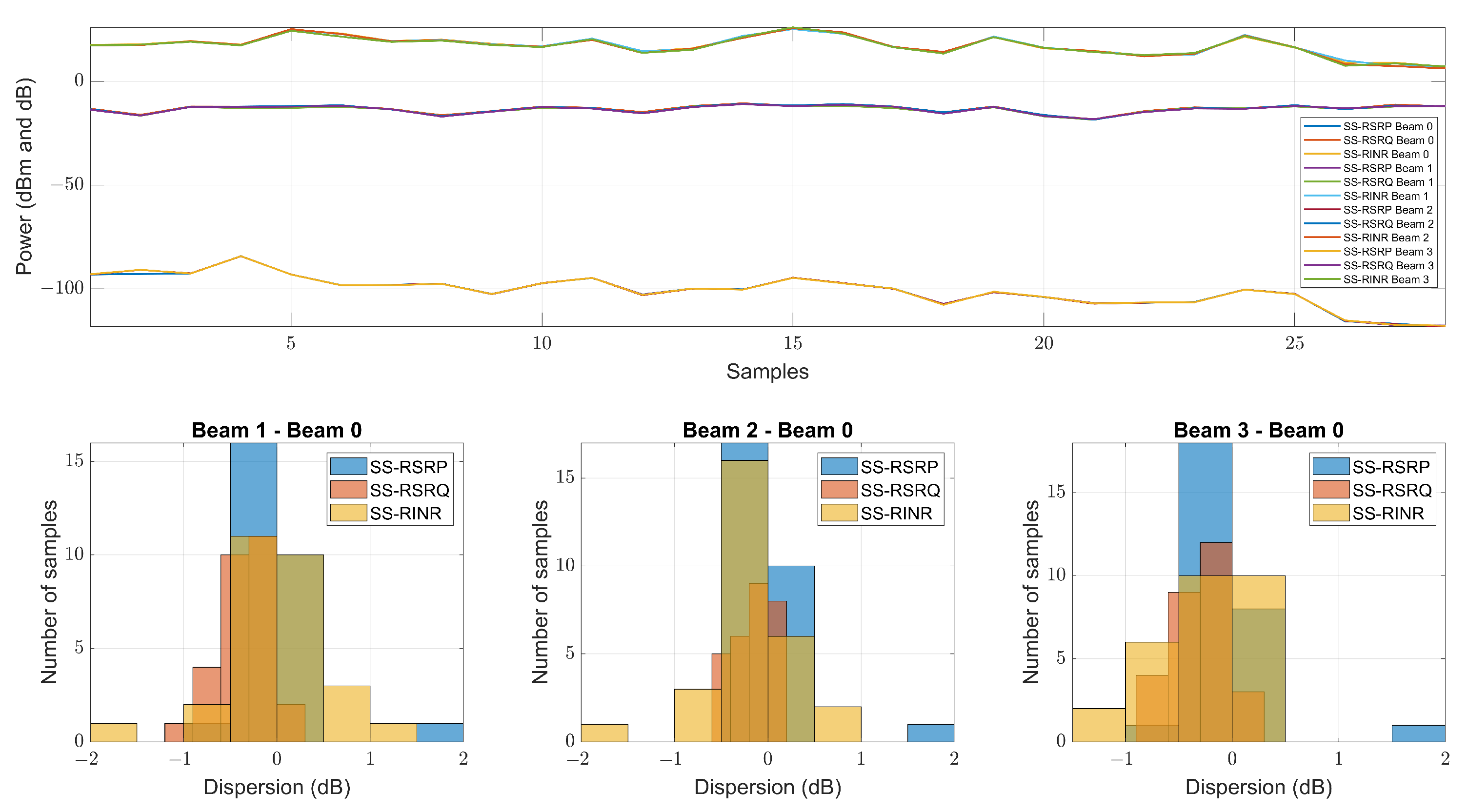



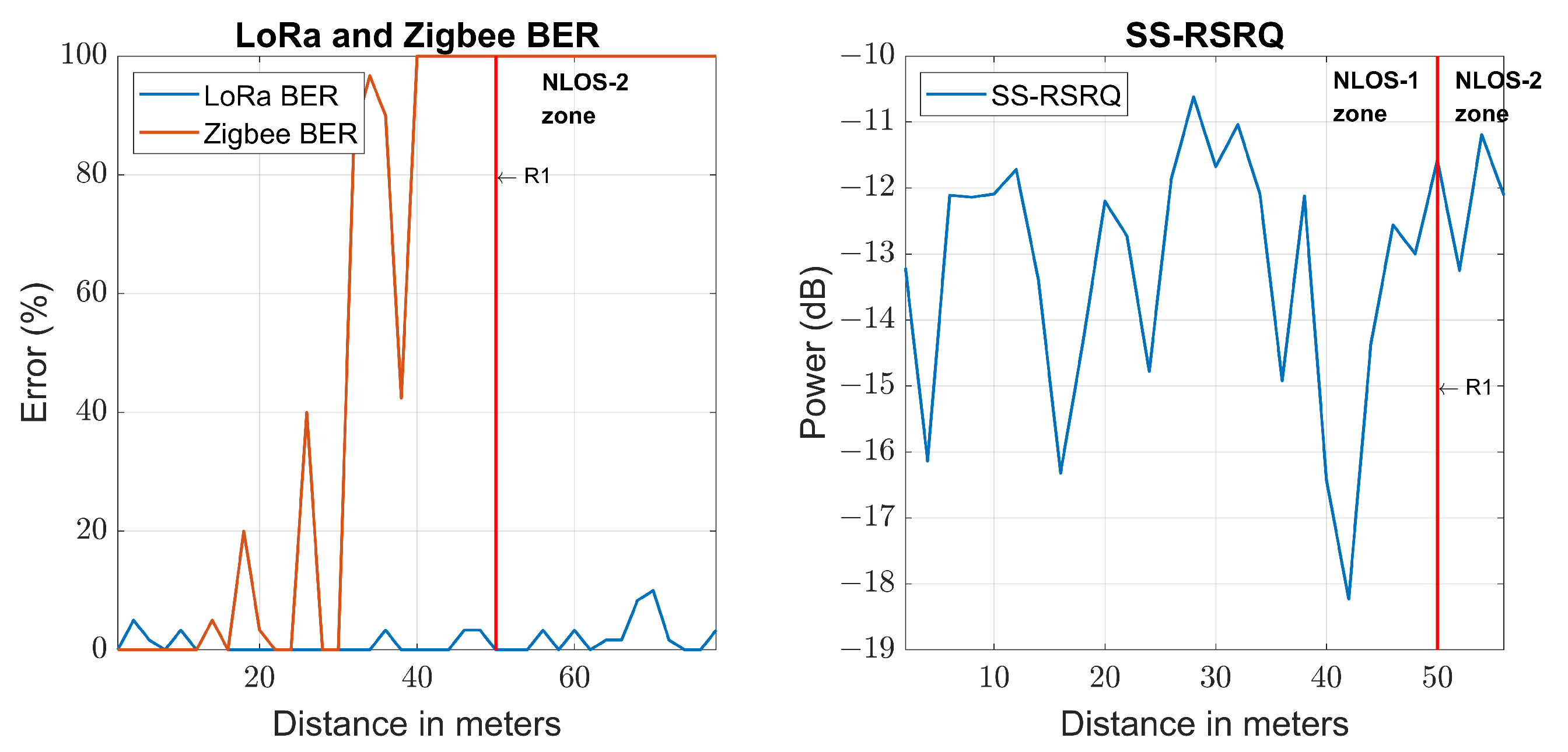



| Ref. | Modulation/Transmission Technology | Frequency | Model | n (Slope) |
|---|---|---|---|---|
| [16] | BPSK | 868 MHz | CI | NSC 1.98, WSC 1.44 |
| [26] | LoRa | 868 MHz | CI | LOS 2.5–2.75 |
| [28] | LoRa | 920 MHz | CI | LOS 2.19, NLOS 3.87 |
| [29] | LoRa | 915 MHz | CI | LOS 3.03, NLOS 4.81 |
| [31] | Zigbee | 2.4 GHz | 802.15.4A | LOS 1.63, NLOS 3.07 |
| [35] | VNA | 26 GHz | CI | Corridor: LOS 1.61, NLOS 3.80 |
| [35] | VNA | 26 GHz | CI | Stairwell: LOS 1.68, NLOS 4.18 |
| [35] | VNA | 38 GHz | CI | Corridor: LOS 1.69, NLOS 3.54 |
| [35] | VNA | 38 GHz | CI | Stairwell: LOS 2.76, NLOS 3.97 |
| [36] | mBECS | 28 GHz | CI | LOS 2.16, NLOS 3.81 |
| [39] | CW | 40 GHz | CI | LOS 1.8, NLOS 2.9 |
| [39] | CW | 40 GHz | FI | LOS 1.8, NLOS 2.9 |
| [40] | VSG | 3.5 GHz | FI | LOS 1.55, NLOS 2.96 |
| [42] | V2X | 5.89 GHz | CI | LOS 1.917 |
| [43] | CW | 1300 MHz | CI | LOS 1.5–1.8, NLOS 2.4–2.8 |
| [44] | CW | 1300 MHz | CI | LOS 1.79, NLOS 2.81 |
| [45] | - | 1300 MHz | CI | LOS 2.2 |
| [46] | NB CW | 914 MHz | CI | LOS 1.8–2.2, NLOS 3.25 |
| [47] | CW | 914 MHz | CI | LOS 1.9, NLOS 2.4 |
| [48] | VNA | 5 GHz | CI | LOS 1.7, NLOS 3.5 |
| [49] | DPSK | 850 MHz | CI | NLOS 3 |
| [50] | SIMO | 2.4 GHz | CI | LOS 2.1, NLOS 2.959 |
| [51] | NB CW | 2 GHz | CI | LOS 2.0, NLOS 2.8 |
| [51] | NB CW | 2.9 GHz | CI | LOS 1.6, NLOS 3.1 |
| [52] | NB CW | 4.5 GHz | CI | LOS 2.31, NLOS 3.69 |
| [52] | NB CW | 4.5 GHz | FI | LOS 1.32, NLOS 4.85 |
| Parameters | Value |
|---|---|
| Center Frequency | 868 MHz |
| SPAN | 200 kHz |
| Frequency STEP | 100 Hz |
| RBW | 10 kHz |
| VBW | 1 kHz |
| VBW Type | Linear |
| RBW:VBW | 3 |
| SPAN:RBW | 100 |
| Trace Type | Average |
| Detector Type | RMS/Avg |
| AVERAGES | 100 |
| SWEEP POINTS | 100 |
| Integration BW | 40 kHz |
| Model | Transmission | Zone | (dB) | n | (dB) |
|---|---|---|---|---|---|
| CI | Narrowband | NLOS-1 | 31.21 | 1.97 | 5.08 |
| NLOS-2 | 31.21 | 3.03 | 4.56 | ||
| CI | LoRa RSSI | NLOS-1 | 31.21 | 1.96 | 4.47 |
| NLOS-2 | 31.21 | 3.01 | 2.33 | ||
| CI | Zigbee RSSI | NLOS-1 | 31.21 | 1.98 | 3.31 |
| NLOS-2 | - | - | - | ||
| CI | 5G SS-RSRP | NLOS-1 | 31.21 | 1.91 | 4.76 |
| NLOS-2 | 31.21 | 3.15 | 0.01 | ||
| FI | Narrowband | NLOS-1 | 31.79 | 1.94 | 5.1 |
| NLOS-2 | −45.94 | 7.26 | 3.89 | ||
| FI | LoRa RSSI | NLOS-1 | 34.63 | 1.72 | 4.38 |
| NLOS-2 | 2.44 | 4.59 | 2.16 | ||
| FI | Zigbee RSSI | NLOS-1 | 35.32 | 1.69 | 3.13 |
| NLOS-2 | - | - | - | ||
| FI | 5G SS-RSRP | NLOS-1 | 42.56 | 1.11 | 3.78 |
| NLOS-2 | −42.65 | 7.39 | 0.013 |
| NB Power | LoRa RSSI | Zigbee RSSI | SS-RSRP | |
|---|---|---|---|---|
| LoRa BER (>5%) | −88 dBm | −119 dBm | Out of range | Out of range |
| Zigbee BER (>5%) | −56 dBm | −94 dBm | −97 dBm | −98 dBm |
| 5G SS-RSRQ (<−18 dB) | −81 dBm | −114 dBm | Out of range | Out of range |
| Power Example | LoRa BER | Zigbee BER | 5G SS-RSRQ | |
|---|---|---|---|---|
| Narrow band power | −61 dBm | 0% | 86.93% | −11.04 dB |
| LoRa RSSI | −98 dBm | 0% | 86.67% | −11.04 dB |
| Zigbee RSSI | −91 dBm | 0% | 0% | −12.14 dB |
| 5G SS-RSRP | −103 dBm | 3.33% | 100% | −13 dB |
Disclaimer/Publisher’s Note: The statements, opinions and data contained in all publications are solely those of the individual author(s) and contributor(s) and not of MDPI and/or the editor(s). MDPI and/or the editor(s) disclaim responsibility for any injury to people or property resulting from any ideas, methods, instructions or products referred to in the content. |
© 2023 by the authors. Licensee MDPI, Basel, Switzerland. This article is an open access article distributed under the terms and conditions of the Creative Commons Attribution (CC BY) license (https://creativecommons.org/licenses/by/4.0/).
Share and Cite
Robles-Enciso, R.; Morales-Aragón, I.P.; Serna-Sabater, A.; Martínez-Inglés, M.T.; Mateo-Aroca, A.; Molina-Garcia-Pardo, J.-M.; Juan-Llácer, L. LoRa, Zigbee and 5G Propagation and Transmission Performance in an Indoor Environment at 868 MHz. Sensors 2023, 23, 3283. https://doi.org/10.3390/s23063283
Robles-Enciso R, Morales-Aragón IP, Serna-Sabater A, Martínez-Inglés MT, Mateo-Aroca A, Molina-Garcia-Pardo J-M, Juan-Llácer L. LoRa, Zigbee and 5G Propagation and Transmission Performance in an Indoor Environment at 868 MHz. Sensors. 2023; 23(6):3283. https://doi.org/10.3390/s23063283
Chicago/Turabian StyleRobles-Enciso, Ricardo, Isabel Pilar Morales-Aragón, Alfredo Serna-Sabater, María Teresa Martínez-Inglés, Antonio Mateo-Aroca, Jose-María Molina-Garcia-Pardo, and Leandro Juan-Llácer. 2023. "LoRa, Zigbee and 5G Propagation and Transmission Performance in an Indoor Environment at 868 MHz" Sensors 23, no. 6: 3283. https://doi.org/10.3390/s23063283
APA StyleRobles-Enciso, R., Morales-Aragón, I. P., Serna-Sabater, A., Martínez-Inglés, M. T., Mateo-Aroca, A., Molina-Garcia-Pardo, J.-M., & Juan-Llácer, L. (2023). LoRa, Zigbee and 5G Propagation and Transmission Performance in an Indoor Environment at 868 MHz. Sensors, 23(6), 3283. https://doi.org/10.3390/s23063283







